In today’s competitive logistics industry, Trucking Management Software (TMS) has become an essential tool for carriers, freight brokers, and shippers aiming to improve efficiency, reduce costs, and maintain compliance. The right TMS can transform daily operations, offering automation, real-time insights, and seamless communication between dispatchers, drivers, and customers.
What is Trucking Management Software?
Trucking management software is a specialized digital platform designed to help fleet owners, trucking companies, and logistics providers streamline their operations. It integrates critical business processes such as dispatching, route planning, driver management, fuel tracking, invoicing, and compliance reporting into one centralized system.
By replacing manual processes and disconnected tools, a trucking TMS software ensures faster decision-making, reduced operational errors, and improved profitability.
Key Features of a High-Quality Trucking Management Software
1. Real-Time Fleet Tracking
With GPS-enabled tracking, businesses gain instant visibility into their fleet’s location, movement, and status. This feature helps optimize delivery schedules, reduce idle time, and improve customer satisfaction by providing accurate ETAs.
2. Automated Dispatching
A robust TMS allows automated dispatching, matching the right driver and vehicle to each job based on factors like availability, proximity, and load type. This eliminates guesswork and reduces downtime between loads.
3. Route Optimization
By analyzing traffic conditions, delivery windows, and fuel costs, route optimization tools help drivers follow the most efficient paths, saving time and reducing fuel expenses.
4. Driver Management and Performance Monitoring
The system tracks driver hours, safety records, and performance metrics to ensure compliance with regulations such as Hours of Service (HOS). This not only improves safety but also helps reward high-performing drivers.
5. Load and Freight Management
From load planning to freight rate calculation, a TMS simplifies load assignments and ensures accurate billing. This minimizes disputes and improves operational transparency.
6. Integrated Accounting and Invoicing
Advanced TMS platforms include built-in accounting features or integrations with tools like QuickBooks, enabling seamless invoicing, payment tracking, and expense management.
7. Compliance and Reporting Tools
Keeping up with DOT, IFTA, and ELD requirements can be challenging. A quality TMS automates reporting, ensuring that businesses remain compliant with local and federal regulations.
Benefits of Implementing Trucking Management Software
1. Increased Operational Efficiency
Automation reduces paperwork, manual data entry, and human error. Dispatchers and managers can focus on strategic decision-making rather than routine administrative tasks.
2. Reduced Operating Costs
Optimized routes, improved fuel management, and preventive maintenance schedules lead to significant cost savings.
3. Better Customer Service
With accurate tracking and automated notifications, customers receive real-time updates, improving trust and satisfaction.
4. Enhanced Compliance and Safety
Automated logs, driver alerts, and safety monitoring ensure regulatory compliance and minimize risk.
5. Data-Driven Decision Making
Advanced reporting tools give managers clear insights into performance metrics, helping them identify trends, address issues, and make informed business decisions.
Choosing the Right Trucking Management Software
When selecting a TMS, consider:
- Scalability – Can it grow with your business?
- Integration – Does it work with your existing accounting, GPS, or warehouse systems?
- Ease of Use – Is the interface intuitive for both drivers and back-office staff?
- Mobile Accessibility – Can drivers update job statuses and receive dispatch orders on the go?
- Customer Support – Is there reliable, 24/7 assistance when issues arise?
Best Practices for Implementing a TMS
- Conduct a Needs Assessment – Identify the specific challenges you need to solve.
- Choose a Pilot Team – Test the system with a small group before full rollout.
- Train Your Staff – Provide hands-on training to ensure smooth adoption.
- Integrate with Existing Systems – Maximize efficiency by connecting your TMS to GPS, ELD, and accounting tools.
- Monitor and Adjust – Use reporting tools to track performance and make improvements over time.
Trucking Management Software Trends to Watch
1. Artificial Intelligence and Predictive Analytics
AI is enabling TMS platforms to predict delivery times, optimize routes in real-time, and anticipate maintenance needs.
2. Cloud-Based Solutions
Cloud TMS systems offer scalability, accessibility, and cost-efficiency, making them ideal for small to mid-sized fleets.
3. Integration with IoT Devices
Sensors and IoT technology are providing real-time data on vehicle health, cargo temperature, and driver behavior.
4. Blockchain for Secure Transactions
Blockchain technology ensures secure, transparent, and tamper-proof freight transactions, reducing disputes.
How Trucking Management Software Impacts the Supply Chain
A well-implemented TMS improves the entire supply chain by:
- Enhancing visibility from warehouse to final delivery.
- Reducing bottlenecks in scheduling and dispatching.
- Improving coordination between carriers, brokers, and shippers.
- Delivering faster and more reliable shipments to customers.
Investing in Trucking Management Software is no longer optional – it’s a strategic necessity for companies that want to stay competitive, compliant, and profitable. The right TMS brings automation, accuracy, and visibility to every step of the trucking process, enabling fleet operators to make informed decisions and deliver exceptional service.

